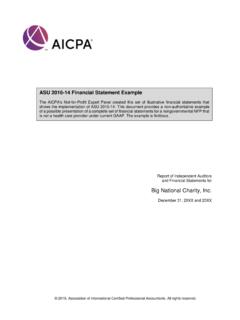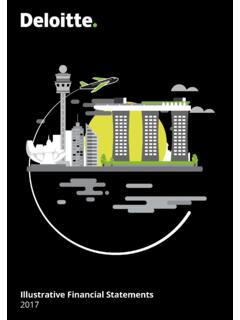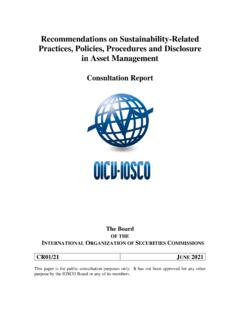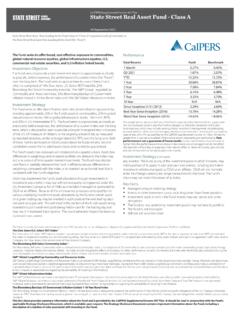Transcription of INTERNATIONAL FINANCIAL REPORTING STANDARDS
1 26 NEWS FOREIGNINTERNATIONAL FINANCIAL REPORTING STANDARDSBIATEC, Volume XIII, 11/2005 INTERNATIONAL FINANCIAL REPORTING STANDARDS (IFRSs)are set by the INTERNATIONAL Accounting StandardsBoard (IASB), which was established in 2001 to repla-ce the INTERNATIONAL Accounting STANDARDS Committee(IASC). IASB members are accounting organisationsthat are members of the INTERNATIONAL Federation ofAccountants (IFAC).The main objectives of the IASB are: to formulate and publish accounting STANDARDS to beobserved in the presentation of FINANCIAL statements to work generally for the improvement and harmoni-sation of regulations, accounting STANDARDS and pro-cedures relating to the presentation of FINANCIAL are at present being used: as a basis for national regulations on accountancy, as an INTERNATIONAL benchmark for countries whichare developing their own national regulation, as a uniform benchmark for multinational and inter-national enterprises, by companies listed on world stock include.
2 An introduction and preface, a framework, IFRSs and INTERNATIONAL Accounting STANDARDS (IASs), interpretations by the INTERNATIONAL FINANCIAL Repor-ting Interpretations Committee, previously called theStanding Interpretations Committee (SIC). INTERNATIONAL Accounting STANDARDS was the nameused for all the STANDARDS until the end of 2002, and In-ternational FINANCIAL REPORTING STANDARDS has beenused since STANDARDS are applicable until the time that theIASs have been replaced by the FINANCIAL REPORTINGSTANDARDS prof. Ing. Vikt ria ejkov , PhD., Ing. Eva H blov , of Economics and Administration, Masaryk University in BrnoA fundamental change in the preparation of FINANCIAL statements is taking place for those enterprisesin European Union Member States which are issuers of securities listed on EU stock preparing their consolidated and non-consolidated FINANCIAL statements for 2005, all such enterprises are required to use INTERNATIONAL FINANCIAL REPORTING STANDARDS instead of national accounting regulations1.
3 1 Commission Regulation (EC) 1725/2003 of adoptingcertain INTERNATIONAL Accounting STANDARDS in accordance withRegulation 1606/2002 of the European Parliament and of of FINANCIAL StatementsIAS2 InventoriesIAS7 Cash Flow Statements IAS8 Accounting Policies, Changes in Accounting Estimates, and ErrorsIAS 10 Events After the Balance Sheet DateIAS 11 Construction ContractsIAS 12 Income TaxesIAS 14 Segment ReportingIAS 16 Property, Plant and EquipmentIAS 17 LeasesIAS 18 RevenueIAS 19 Employee BenefitsIAS 20 Accounting for Government Grants and Disclosure of GovernmentAssistance IAS 21 The Effects of Changes in Foreign Exchange RatesIAS 23 Borrowing CostsIAS 24 related Party DisclosuresIAS 26 Accounting and REPORTING by Retirement Benefit PlansIAS 27 Consolidated FINANCIAL Statements and Accounting for Investmentsin Subsidiaries IAS 28 Investments in AssociatesIAS 29 FINANCIAL REPORTING in Hyperinflationary EconomiesIAS 30 Disclosures in the FINANCIAL Statements of Banks and Similar Fi-nancial InstitutionsIAS
4 31 Interests in Joint VenturesIAS 32 FINANCIAL Instruments: Disclosure and PresentationIAS 33 Earnings Per ShareIAS 34 Interim FINANCIAL ReportingIAS 35 Discontinuing OperationsIAS 36 Impairment of AssetsIAS 37 Provisions, Contingent Assets and Contingent LiabilitiesIAS 38 Intangible AssetsIAS 39 FINANCIAL Instruments: Recognition and MeasurementIAS 40 Investment PropertyIAS 41 AgricultureIFRS 1 First-time Adoption of INTERNATIONAL FINANCIAL REPORTING StandardsIFRS 2 Share-based PaymentIFRS 3 Business CombinationsIFRS 4 Insurance ContractsIFRS 5 Non-current Assets Held for Sale and Discontinued OperationsTable 1 List of STANDARDS applicable as at 1 January , Volume XIII, 11/2005 NEWS FOREIGNINTERNATIONAL FINANCIAL REPORTING STANDARDSIn addition to the STANDARDS themselves, interpretati-ons are issued in order to clarify certain provisions of anoriginal standard.
5 Interpretations for IASs were develo-ped by the Standing Interpretations Committee (SIC)and those for IFRSs are developed by the InternationalFinancial REPORTING Interpretations Committee).The STANDARDS are divided into four main parts: definitions measurement of the elements of FINANCIAL statements recognition of the elements of FINANCIAL statements disclosure requestsFor certain STANDARDS , an enterprise may choose fromtwo treatments of a particular issue, either a "ben-chmark" treatment or an "allowed alternative" framework defines the terms used as the basisfor the preparation and presentation of FINANCIAL state-ments.
6 The framework is not a standard and it does notdefine the standard treatment of any issue. Shoulda conflict arise between the concept framework anda particular standard, the requirements of the standardtake framework defines: the objective of FINANCIAL statements, basic conditions for the preparation and presentationof FINANCIAL statements, qualitative characteristics, the measurement and recognition for basic elementsof FINANCIAL statements, the capital maintenance framework is designed for FINANCIAL statements,including consolidated ones. It may be used for any en-terprises focused on commerce, industry or entreprene-urial activity, whether in the private sector or state objective of FINANCIAL statements is to provide in-formation on the FINANCIAL Position, Performance, andChanges in the FINANCIAL Position of an assumptions made for the preparation and pre-sentation of FINANCIAL statements are Acrual Basis andGoing features which make the FINANCIAL statementscomprehensible for the user are the qualitative charac-teristics.
7 They include Understandability, Relevance,Reliability, and basic elements of FINANCIAL statements related tothe FINANCIAL position are Assets2, Liabilities3and Equ-ity4. The basic elements related to performance are Ex-penses5and elements of FINANCIAL statements are valued atHistorical Cost, Current Cost, Realisable-SettlementValue and Present choice of capital concept is determined by therequirements of those who use the FINANCIAL state-ments of an enterprise. A distinction is made betweenFinancial Capital Maintenance and Physical for the implementation of the IFRSs To ensure that the transition to IFRSs is managed su-ccessfully.
8 The Committee of European Securities Re-SIC7 Introduction of the EuroSIC10 Government Assistance No Specific Relationto Operating ActivitiesSIC12 Consolidation Special Purpose EntitiesSIC13 Jointly Controlled Entities Non-Monetary Contributions by VenturersSIC15 Operating Leases IncentivesSIC21 Income Taxes Recovery of Revalued Non-Depreciable AssetsSIC25 Income Taxes Changes in the Tax Status of an Enterprise or its ShareholdersSIC27 Evaluating the Substance of Transactions in the Legal Form of a LeaseSIC29 Disclosure Service Concession ArrangementsSIC31 Revenue Barter Transactions Involving Advertising ServicesSIC32 Intangible Assets Website CostsIFRIC1 Changes in Existing Decommissioning, Restoration and Similar LiabilitiesIFRIC2 Members' Shares in Co-operative Entities and Similar InstrumentsIFRIC3 Emission RightsIFRIC4 Determining Whether an Arrangement Contains a LeaseIFRIC5 Rights to Interests Arising from Decommissioning, Restoration and Environmental Rehabilitation FundsTable 2 List of interpretations applicable as at 1 January 2005 2 The assets of an accounting entity represent future economic be-nefits; they may contribute directly or indirectly to the future growthof an enterprise's funds.
9 They are the result of past transactions;having title to assets is not important, but having control over thebenefit they bring is; the certainty of the future economic benefitand the reliability of its valuation are conditions for the presentati-on of liabilities of an enterprise are the current obligations whicharose from past events and which in future will cause an outflowof economic benefits; a sufficient probability of the future outflowof economic resources and the reliability of their valuation are con-ditions for the presentation of represents the residual interest in the assets of an represent the decrease in economic benefits, expres-sed as the loss of or decrease in the useful life of assets or asgrowth in debt, which in the given period leads to a fall in equityother than through withdrawal by the owners.
10 Reliability of mea-surement and a sufficient degree of certainty are conditions fortheir represents an increase in economic benefits, expressedeither as an increase in assets or as a decrease in debt, whichoccurred during the course of the accounting period and whichleads to an increase in equity other than by a contribution from theowners. Reliability of measurement and a sufficient degree of cer-tainty are conditions for their (CESR) has issued a recommendation aimedat both facilitating the transition to IFRSs and providinginvestors with easily understandable FINANCIAL phases: Annual report for 2003 wherein enterprises shouldexplain how they plan to implement the transition toIFRSs presentation of plans for achieving conformi-ty, explanation of differences between the nationalconcept of accountancy and the concept used inIFRSs






